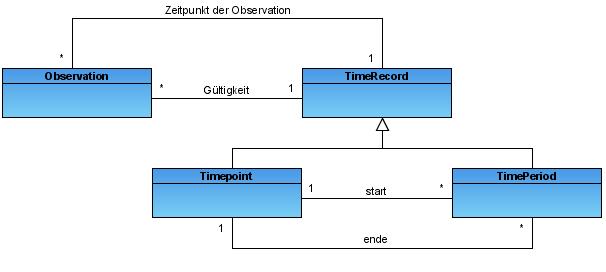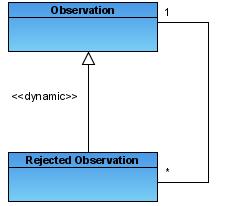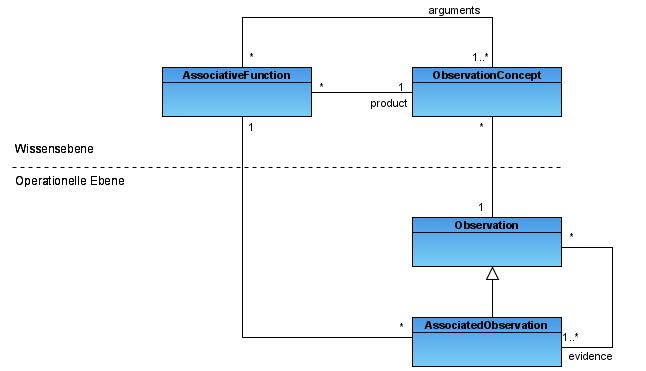Observation (analysis pattern)
Observation ( English for observation) is an analysis pattern from software technology for modeling qualitative properties for an object. The pattern was developed by Martin Fowler in a project for the National Health Service to model the health system and was first described in his book Analysis Patterns in 1996 .
problem
Real world objects can be mapped as data sets, attributes, objects and in other ways in computer systems. There are basically two different possibilities in object-oriented software technology. The information can be stored as an association in the form of a referenced object or as an attribute in the form of a simple data type.
In order to guarantee a clear assignment of measured values and their units and thus exclude a semantic misinterpretation of the international system of units, Martin Fowler developed the quantity pattern.
But as soon as an object more than one measurement (Engl. Measurement incurred) would have in the application of Quantity are several attributes; pattern in the object in the form of references created, which would lead to an unnecessary inflation of the class. Furthermore, it is not possible to map measurement-specific data and to integrate the qualitative properties without expanding the model.
context
Martin Fowler joined a project team of doctors, nurses and analysts as part of a National Health Service project and was entrusted with the task of creating a system for mapping health care from a clinical perspective. His suggestions and examples are therefore based on everyday clinical practice, in particular dealing with the measurement and processing of clinical parameters such as laboratory values, blood groups, disease diagnoses, gender, etc. His models, however, have also been developed for more general solutions (see Motivation of Patterns ).
Observations play an essential role in the medical environment, as they enable specific conditions and measurements to be assigned to a patient at a specific point in time. This fact eventually led Fowler to develop the observation analysis pattern.
Such observations can be blood pressure, eye color, blood group or similar characteristics.
Powers
In his book Analysis Patterns , Martin Fowler introduces the pattern observation on the development of the pattern quantity , conversion ratio , compound units , measurement . The description includes the introduction of the pattern Knowledge Level and the pattern-like structure Phenomenon Type . The measurement pattern was supplemented in the form of the observation pattern, taking into account and processing qualitative information.
solution
Since an object in the health system must also have qualitative (= classifying) properties, but this could not be represented in its previous Quantity , Measurement and Phenomenon patterns , Martin Fowler suggests developing the measurement pattern further as an observation pattern, taking qualitative information into account .
An observation can be a measurement, i.e. it can consist of a unit and a measured value or it can be classified into a category.
A reference to objects of the Observation class is defined for an object ( Person class ) . An observation always occurs in the form of a measurement or an observation category (e.g. male, female; positive, negative; A, AB, B, 0; etc.). Thus, from a conceptual point of view, an instance of the observation type is either an instance of the measurement type or an instance of the observation category. So that this can be implemented during modeling, the modeling language is expanded to include classifications, a generalization of the generalization.
Several phenomena are associated with one type of phenomenon, each phenomenon belongs to exactly one type. The fixed assignment of a category observation to exactly one type of phenomenon occurs via the observed phenomenon. The type of phenomenon indicates what type of perception it is. The set of phenomena associated with a phenomenon type describes all possible results of a category observation of the selected phenomenon type on a person.
The association between phenomenon and phenomenon type forms the knowledge level. The association formalizes rules that would otherwise only have been considered as comments. Knowledge level and operational level are linked in such a way that rule violations are not possible.
The breakdown into knowledge level and operational level does justice to the nature of the recorded data. Objects of the knowledge level change less often than objects of the operational level. To a certain extent, the knowledge level describes the behavior of objects.
example
- The fact that a person belongs to the blood group A is represented a person by a category-observation, the phenomenon of blood group A is. This phenomenon is linked to the blood group phenomenon type .
- The low oil level of a vehicle can be modeled as a category observation. The type of phenomenon is the oil level with possible phenomena too much , OK and too low . The observation links the car with the phenomenon too low .
particularities
1. Dual-Time-Record Observations often have a limited time frame in which they can be applied. The end point of this time window indicates the point at which this observation loses its validity. Usually this observation takes place at a different point in time than the specified time window. This means that there are two time entries: the time window of the validity of the observation and when it was recorded. For this purpose, Fowler constructed the following model.
2. Rejected Observation Faulty observations cannot simply be deleted in the medical environment. B. Treatments or therapies are based on these false observations. In addition, there are a number of legal regulations that must be complied with, e.g. B. Documentation, reporting to the authorities, etc. In order to be able to depict this in the model as well, a Rejected Observation object is inserted. This must be linked to the observation that it rejects.
3. Active observation, hypothesis and projection Especially in the clinical area, 100% verified diagnoses without detailed examinations are the exception. Diagnoses can often only be confirmed after a series of clinical tests and examinations. Up to this point, the clinician makes assumptions about what the patient might have, how this can be proven by tests and how he should be treated accordingly.
From the patient's point of view, there is no certainty for a long time which illness he is suffering from (e.g. observation of thirst, weight loss and polyuria can indicate diabetes; this must be verified by appropriate tests).
So that this fact can be taken into account in Fowler's model, the observations are divided into three subgroups:
Hypothesis: Assumption that should be confirmed by further tests Active Observation: This observation is verified and all treatment steps are based on this observation. Projection: What can happen in the future as a result of the disease?
4. Associated Observation In order to link individual observations with one another (e.g. the patient's excessive thirst can indicate diabetes), Fowler added the extension of Associative Observation. The compilation and evaluation of the individual observations leads to what is known as an Associated Observation, e.g. B. Diabetes mellitus. This associated observation is linked to an associative function, the arguments of which are the observation terms (such as weight loss, thirst, polyuria, etc.). The resulting product is diagnosis, e.g. B. Diabetes mellitus.
See also
- Analysis pattern , overview of known analysis patterns
- Phenomenon , used to typify the measurements
- Quantity , used for the coherent storage of a value with its unit
- Measurement , used to model quantitative measurements for an object
literature
- Martin Fowler: Analysis Patterns . Addison-Wesley, Amsterdam 1996, ISBN 0-201-89542-0 , pp. 35-55 .




